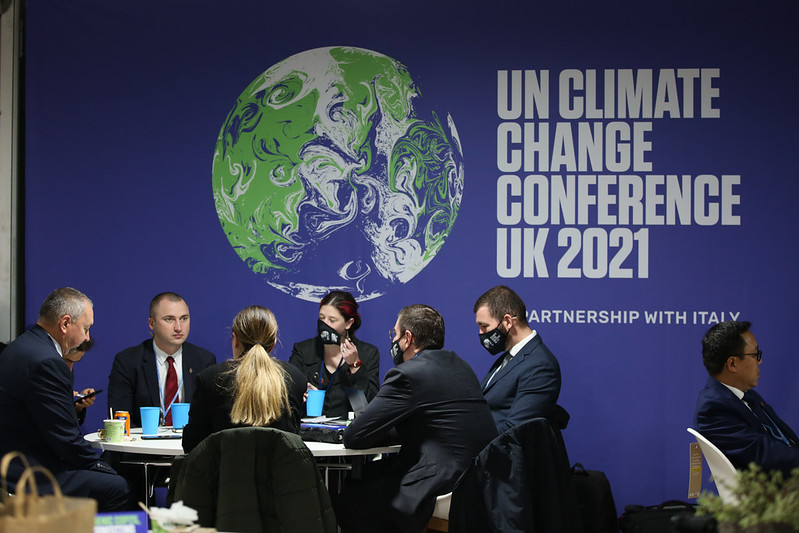
COP26 Glasgow Climate Conference: Now what?
By Samantha Amundarain, December 1 2021—
Since Nov. 1, government leaders have come together in Glasgow, Scotland to discuss and make a plan to reduce global world emissions. The United Nations (UN) climate change conference will take place from the first of the month until Nov. 12. Major political leaders, including Prime Minister Justin Trudeau, US President Joe Biden, UK Prime Minister Boris Johnson, among many others. Some say this could be the last opportunity people have to prevent the most drastic climate change effects.
The urgency of this particular conference stems from the Paris Agreement made in 2015. Several countries signed on to limit global warming to 1.5 degrees Celsius compared to pre-industrial levels by reducing greenhouse gas emissions. Six years later, COP26 in Glasgow is an opportunity to re-evaluate their plans and goals. The strategies laid out in 2015 did not work out, and the world is still far out from lowering its temperature. For this reason, COP26 must be decisive if global emissions are to reach net-zero emissions by 2050.
Trudeau made his statement proposing a global tax on carbon emissions, which he claims will dramatically curve the use of fossil fuels. Before he made this statement, Trudeau should have looked in his backyard to see if Canada’s carbon tax is working. Since 2019, Canadians have been paying $20 per tonne of carbon dioxide equivalent — a price that will steadily increase as the years go by. Currently, it sits at $40 per tonne. As far as effectiveness, it isn’t super clear how well the tax is working if at all. Because of the pandemic, global emissions dropped in large part because people did not need to drive to work every day, for example. Trudeau did admit that implementing the carbon tax nationally was an “uphill battle” in Canada, but that battle was already won. As of right now, only about 20 percent of emissions are covered by the carbon tax. Trudeau would like to have that number tripled by 2030.
Several other political leaders also made pledges and promised to increase their efforts. Biden signed a treaty agreeing to cut the States’ methane emissions to 30 percent of what they were in 2020 by 2030. Along with that, he stated his intention to cut US greenhouse gas emissions by a gigaton by the next decade as well. The political leaders of more than 100 countries, including Brazil, China, Russia and the US, all vowed to end deforestation by 2030.
As politicians discussed, people took to the streets to pressure said politicians into action. Activist Greta Thunberg says, “This COP26 is so far just like the previous COPs and that has led us nowhere. They have led us nowhere.” With the use of some colourful language, she has expressed her disdain for the political leaders for “pretending to take our future seriously.”
It’s time to get real. Cutting out energy industries in less than a decade is — simply put — unrealistic. We’ve already seen these politicians let us down since the Paris Agreement was made. It’s the reason COP26 was so crucial to the future of humanity. Despite this, what the political leaders have delivered are half-baked ideas and unbacked plans. Is there really a realistic way to be rid of deforestation in eight years? If it is, what are we going to replace the energy that comes from the lumber industry? Similarly, fossil fuels currently control Canada’s economy. Its price determines the value of our dollar. Canada as a country heavily depends on fossil fuels in the form of gasoline for transportation of resources and natural gas to heat homes during the long winter months. A carbon tax may make us more aware of how much we emit, but is it really a long-term answer?
On the other hand, protesting is not much more of a solution. Using Thunberg as an example, her consistent calls for immediate and bold action are followed by absolutely no plan. While some of her actions, like sailing to conferences, reduce her carbon footprint, what does she expect to see from the global politicians? They should be stepping up to their promises, that’s true, but her witty one-liners are fanning a flame that has nowhere to go.
So where will we see real action? The responsibility lies with everyone — governments and individuals alike. Keeping up with little actions is better than nothing. Staying informed and holding governments accountable for their actions is also better than nothing. This means more than going out and protesting. Protesting draws attention to the issue but now that everyone is paying attention, what’s next? What’s a realistic and feasible way to reduce carbon emissions on a global scale? Small actions like voting for political candidates willing to spend the money on potential solutions is a start. Having the hard discussion with peers, carpooling, reducing plastic use are all examples of actions that can have even a small impact. Any impact is an important impact.
The answer is not clear. It is crucial to our future how we grow up to shape the world. Actions we, as individuals, take these days can help the world. Even sifting through the words of politicians and realizing what is actually possible versus what is just empty promises can affect everyday actions.
COP26 did not have the bold and decisive action people were hoping to see. After their panels, politicians have made it clear that they have almost certainly no realistic plan to reduce global warming. Hopefully, what can be done will be enough to get the world a couple more years.
This article is part of our Opinions section and does not necessarily reflect the views of the Gauntlet’s editorial board.
